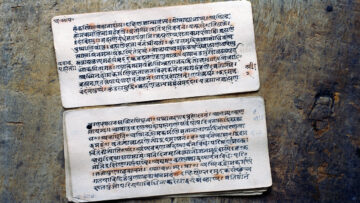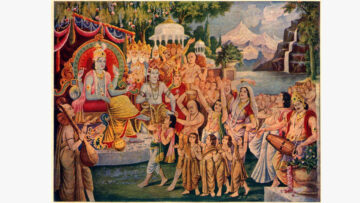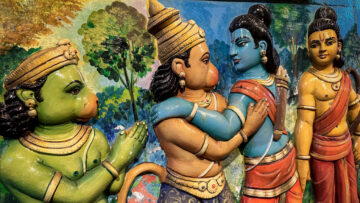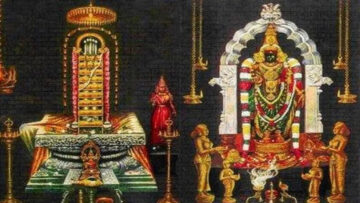Is Death the Final Curtain?
Is death the final curtain of one journey—or merely a pause between two curtain-raisers?
Does it even matter what happens after death? They say, पुनरपि जननं पुनरपि मरणं, पुनरपि जननी जठरे शयनम् (punarapi jananaṃ punarapi maraṇaṃ, punarapi jananī jaṭhare śayanam). These words have always brought tears to my eyes. But do they offer any real solace when grief overwhelms? Do they fill the void left behind by someone who shaped our world?
In that moment of loss, I cannot comprehend philosophical truths. I cannot accept that if there is jananam (birth), there must be maranam (death).
These were the thoughts that crossed my mind when I lost my father.
He was 86, and yet so alive—active, independent, always cheerful. A man who radiated hope and positivity, who touched countless lives with grace. We gave him a beautiful farewell. He took leave of us slowly, gently, almost as if he didn’t want us to feel the pain of parting. We chanted by his side, gave him Gangajal, surrounded him with love and memories of a life well lived.
And yet, I miss him. I ache for the familiar ring of the phone during our brief evening calls—calls that will never be answered again.
And then came the deeper realization: the loss of my mother had cut even more sharply. With time, that pain has dulled, but the emptiness remains. I still feel the impulse to share every little milestone with them. The need for their wisdom, their comforting words, their presence in moments of uncertainty. And when I cannot reach them, I am left with an aching silence.
Just as I was coming to terms with this personal grief, came the devastating news of the Air India crash near Ahmedabad. What about those lives lost in an instant? The passengers, their dreams, their unfinished conversations? Their families had no time for farewells. There were no chants, no Gangajal, just sudden absence. They were waiting—for life to unfold, for dreams to take shape.
What about the ones who go without a moment’s notice? What about the ones they leave behind?
All of us who remain carry regrets—the living do. We grieve, we resolve to live differently, to cherish each day as if it were our last. For a while, we succeed. But time, with its strange mercy, dulls the sharpest pain, smooths over the ache. We return to the routines of life. We carry the void within, sometimes quietly celebrating the moments we have, and at other times drowning in the emptiness they left behind.
We wait—for a word, a sign, a hand to hold. For someone to lift us up and whisper that hope remains.
And yet, in the face of such sorrow, something shifts within.
In those moments of profound despair, when even the kindest words from friends and family cannot fully reach the hollowed heart, we begin to turn inward. It is here—beyond the reach of language—that something deeper stirs. Surprisingly, it is often the very rituals we tend to overlook or take for granted that offer the greatest solace.
While every culture has its own ways of mourning, I wish to share those sacred practices that have touched me most deeply—rites I have witnessed through the passing of my grandparents, my mother, my parents-in-law and most recently, my father. These rituals, rooted in Sanātana Dharma, are not about what is right or wrong by modern standards. Rather, they carry within them a quiet purpose: to anchor the grieving, to honour the departed, and to help the living continue—mindful of the love and legacy left behind.
The 13 Days of Farewell: A Journey Through Ritual and Remembrance
In the Sanātana Dharma tradition, death is not seen as an end but as a sacred passage—a transition of the soul (jīvātma) from one state of being to another. It is not only the release of the soul from the physical body (deha-tyāga), but also a deeply structured period of support for both the departed and the grieving family. Among Tamil Iyer Brahmins, this transition is honoured through a set of meticulously observed rites that unfold over thirteen days.
These days are not mere customs, nor are they simply obligations to be checked off. Each ritual is charged with symbolic meaning, ancestral memory, and spiritual intent. They serve a twofold purpose: to help the soul navigate its onward journey, and to offer structure and sanctity to the living, who are suddenly plunged into the stillness of absence.
Day 1 – Antyeshti: The Final Offering
The moment death occurs, time stands still—but tradition quietly steps in to guide the family. The body is bathed, anointed, wrapped in white cloth, and laid with sacred leaves—tulasi, vilvam, or darbha. It is a final act of dignity.
The karta, usually the eldest son or nearest male relative, performs the cremation rites, invoking Agni to carry the soul forward. Vedic mantras accompany the fire, as if reciting the soul’s final lullaby on earth. The first pinda—a rice ball offered to the soul—is placed, initiating the journey from preta (departed) to pitṛ (ancestor).
Days 2 to 9 – A Bridge of Offerings
For the next eight days, the family remains in a state of saucham (ritual impurity), marking their withdrawal from worldly routine and immersing themselves in remembrance. Each day, pindas—rice balls with sesame and ghee—are offered, and tila tarpana (libations of sesame water) is performed.
It is believed that during these days, the soul gradually sheds its earthly impressions and gains clarity. These offerings guide the preta across subtle planes, helping it relinquish attachments and journey forward. For the family, these acts become meditative—daily rituals of remembrance, of quiet continuity amidst the ache of absence.
Day 10 – The Turning Point: Letting Go, Gently
The tenth day marks a quiet but powerful shift in the journey. Until now, the rites have been centred on tending to the soul’s fragile passage, and the family’s fresh grief. But Day 10 introduces the idea of release—of letting go, gently and ritually.
Ten pindas, representing the impressions (vasanas) of the soul, are gathered and ceremonially dissolved—often in flowing water or earth. This symbolic act signifies the loosening of worldly bonds and the soul’s readiness to move onward. It is believed that by this point, the soul begins to stabilize in its new state, prepared for integration with the ancestors.
Rituals may include Vishnudhara, where water flows continuously over the pindas while Vishnu mantras are chanted, invoking the steady passage of time and divine grace.
For the family, Day 10 is a deeply emotional juncture. The rituals evoke a different kind of grief—not just of presence lost, but of presence transforming. There is no final goodbye yet, but something lifts—a subtle acceptance, a quiet strength that begins to emerge.
Day 11 – Elevation and Merit: Ekādaśa Rites
The eleventh day marks a shift in tone—from mourning to upliftment. Homams are performed—often including Rudra Homa or Vishnu Homa—to purify and elevate the soul. Offerings of clothes, vessels, and symbolic cows (godāna) are made, representing the family’s relinquishing of earthly ties on behalf of the departed.
This day also includes Preta Dāna, symbolic donations that relieve the soul of lingering karmic debts. The prayers here are no longer only for release—they are for well-being, peace, and divine integration.
Day 12 – Sapindikaranam: Becoming One with the Ancestors
This is a pivotal day. In the Sapindikaranam rite, the individual soul is ritually merged into the lineage of ancestors. Three pindas are offered to the paternal forefathers—father, grandfather, great-grandfather—and a fourth pinda, representing the newly departed, is unified with them.
It is a moment of sacred belonging. The soul is no longer a wandering preta, but a pitṛ—an honoured elder, remembered in every future śrāddha, a guardian of the family’s spiritual continuity.
Day 13 – Conclusion and Continuity: Samaradhana
The thirteenth day marks the conclusion of the mourning period. The family performs a samaradhana, a meal and offering to Brahmins and well-wishers, not in celebration, but in quiet acceptance. Prayers are recited, blessings received, and the family steps out of ritual saucham back into life—changed, marked, but accompanied now by the memory of rites completed with devotion.
The soul has been guided; the grief, honoured; the living, supported.
A Living Ritual
These thirteen days are not merely about the one who has passed—they are just as much for those who remain. For the karta, the siblings, the family grappling with the everyday absence, these rites create a container for sorrow, a rhythm to grief, and a sacred vocabulary for remembrance.
In these carefully structured days, we are reminded that while death may be inevitable, forgetfulness is not. Sanātana Dharma offers us a way to mourn—anchored in meaning, enriched by generations, and infused with both surrender and strength.
A daughter is always loved in a way that is different, and often deeper. It is an undeniable truth whispered through generations: she is the Lakshmi of the home. In time, she transforms into the quiet strength of a mother, especially as her parents grow old. She becomes their caretaker, their anchor, their confidante.
In the framework of Sanātana Dharma, even grief acknowledges this sacred bond. The daughter, though often unseen in formal ritual roles, is given moments of intimate, irreplaceable farewell—rituals that are as heart-wrenching as they are healing.
On the first day, as the body is prepared for the final rites, it is the daughter who gives the last bath. This moment—so simple and yet profound—is not just a physical act. It is a gesture laden with love and gratitude, as if to say: You bathed me, nurtured me, carried me through the stages of life. Today, I bathe you one last time—not as a mourner, but as your child, releasing you from all duties and all bonds, with love.
In that silent ritual, no words are needed. The final bath is not about ritual purity; it is about emotional closure. It is the daughter’s unspoken shraddha—a sacred offering from the heart.
And then comes the tenth day—that silent shift when the soul is guided from the state of a preta to that of an ancestor in the making. The rituals of the day are solemn, symbolic, and emotionally charged. But amidst the chants and libations, there is another quiet gesture of transformation—one that often goes unnoticed in formal texts but lives on through lived tradition.
It is the daughter, not the karta, who steps forward to feed the guests—those who have come to witness, to support, and to honour the soul’s journey. This act is not merely one of domestic responsibility. It carries ritual and emotional weight, for feeding on this day is no ordinary offering.
The food served is not simply nourishment—it is shraddha, a gesture of sacred continuity. And the daughter, who once received everything from her parents—love, protection, food, identity—now becomes the giver. She becomes the extension of her parents’ anna-dāna legacy. In serving each guest, she is not just performing a social duty. She is saying, “You fed me with love, and through me, you continue to feed others. I carry you forward in every gesture of care and service.”
It is a moment of quiet empowerment, a sacred role passed on without ceremony, yet bearing the full emotional gravity of the occasion. In a world that often places the karta at the center of ritual, it is in this gesture that the daughter becomes the axis of grace—her love flowing not through mantras but through ladles, not through rites but through remembrance.
This is how Sanātana Dharma speaks softly through roles, not rules. It recognizes the power of the feminine, not always in loud declarations, but in these silent, sustaining acts of love that help a family move from loss to light.
I don’t know if I should call myself fortunate—that I carry forward the legacy of my parents, their values, their quiet strength, the way they lived with dignity and gave with love. Or do I call it poignant—that I must carry this legacy alone, bearing its weight with grace, but without their physical presence to guide me anymore?
There are moments when I feel their nearness in the smallest things—in a phrase they once said, in the way light filters through a window, in the scent of food they loved, or the habits they passed on without saying a word. And yet, the ache remains: that I cannot turn to them for advice, for comfort, for that one approving smile that made everything feel right.
To carry their legacy is an honour. But to do so without them is the very ache of living.
Days 11 and 12 pass in a hush—intimate, almost esoteric in nature. These are not days one speaks much about; they are more about inner integration than outward ritual. A sense of stillness settles in, as if the soul has found its place and the family, a momentary quiet. On the 13th day, with the samaradhana, we slowly re-enter the world. The rituals come to a formal close, but what they leave behind is not closure—only a way to carry the absence with grace.
Though the karta refrains from celebrating festivals or visiting temples for a year, the daughter is allowed to gently move on with her life. Her role, intimate and emotional, is fulfilled in those initial days of farewell. But for the karta, the journey continues—he carries the responsibility of keeping the rituals alive, ensuring that the ātmā is nourished through śrāddha and remembrance. This is his debt to the pitṛs, a sacred duty he alone must fulfil.
It is a quiet burden—one that he carries not with complaint, but with love. In each offering, he honours not just the departed, but the very lineage that gave him life.
Sanātana Dharma, in its vastness and compassion, does not exclude those without sons. For those who have no karta in the traditional sense, the rituals adapt. Daughters, relatives, or even appointed ritviks can perform the necessary rites. What matters is the intent, the shraddhā—the faith and sincerity with which the rites are done. The soul is not denied its journey simply because of family circumstance. Dharma, at its core, is inclusive. The tradition recognises that love and remembrance transcend gender, and that the path to peace for the departed lies in the sincerity of those left behind.
As the thirteen days unfold, they become more than just a set of rituals. They are filled with countless moments when we think of the departed soul—not only in grief, but in deep gratitude. We remember how they shaped our lives, how they quietly sowed the seeds of who we have become. And in that remembering, we begin to understand our duty—to carry forward their legacy, to fulfill the dreams they held for us, and to live in a way that honours their presence.
These days make us realise: this is not the end. They live on through us—in our thoughts, our actions, our values. What they stood for, we now uphold. And it becomes our responsibility to pass those values on to the next generation. That, truly, is the meaning of lineage—not just blood, but the transmission of dharma.
In walking through these rites, we come to see death not as a full stop, but as another chapter in the vast, eternal cycle of birth and rebirth. And somewhere deep within, we are reminded of the ultimate truth: that one day, we too will journey beyond—and when the time is right, merge into the One from which we came.
“Therefore, over the unavoidable, you should not grieve.” (Bhagavad Gītā 2.27)
जातस्य हि ध्रुवो मृत्युर्ध्रुवं जन्म मृतस्य च ।
तस्मादपरिहार्येऽर्थे न त्वं शोचितुमर्हसि ॥ २.२७
jātasya hi dhruvo mṛtyur dhruvaṁ janma mṛtasya ca
tasmād aparihārye ’rthe na tvaṁ śocitum arhasi || 2.27
“For one who is born, death is certain; and for one who has died, birth is certain again. Therefore, over the unavoidable, you should not grieve.”
May their souls find peace. May we find strength. May the eternal cycle lead us all to oneness.
(Author’s note: The reflections shared here are drawn from personal experience and offer only a glimpse into the broader canvas of rituals observed during the thirteen-day mourning period. These are not comprehensive instructions. Only those deeply versed in the śāstras and traditions can truly guide one through the full sanctity of these rites.)
Feature Image Credit: wikipedia.org
Disclaimer: The opinions expressed in this article belong to the author. Indic Today is neither responsible nor liable for the accuracy, completeness, suitability, or validity of any information in the article.










